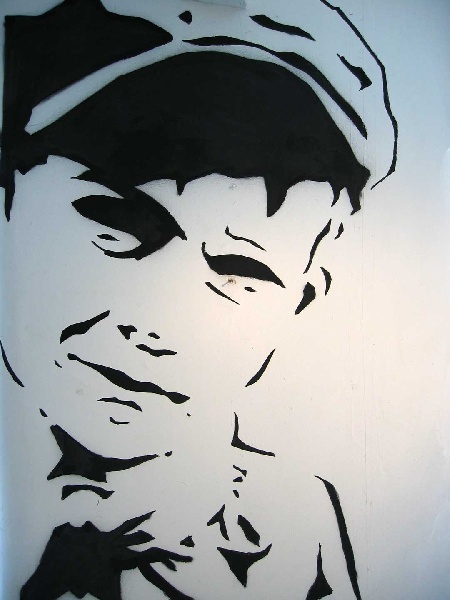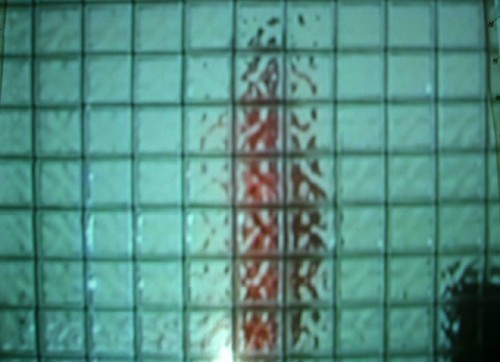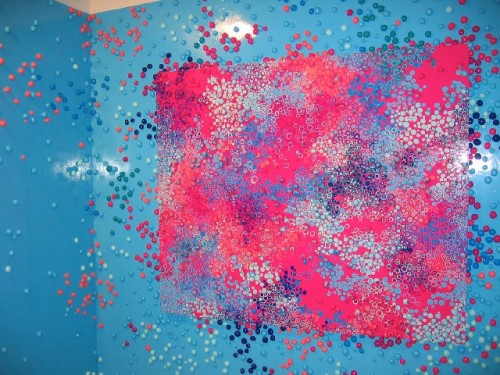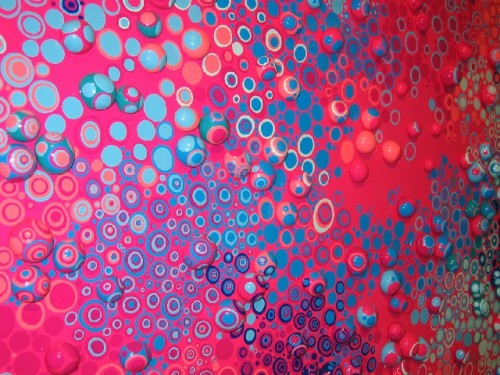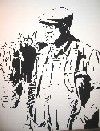The Politics of Space
Off The Streets
By: Jane Hudson - Sep 04, 2006
Contemporary Artists Center, Beaver St., North Adams, MA, Aug. 26-Sept. 22
As it's last show of the summer season, the CAC presents four installations, the first of which is 'Off the Streets', "an immersive environment of individual and collective assemblages on and with wood, metal, glass, paper and other found objects by Josh McPhee, Billy Mode and Chris Stain."
'Agitprop' is historically associated with the Communist propaganda machine, and has come to suggest a strategy used by oppositional groups. Of course in its application by states and corporations it can also 'agitate' the populace to conform. In the instance of this exhibition at the CAC, the agitational propaganda addresses the themes of racism, poverty, ecological threats and labor unrest. Using the graphic boldness of public graffiti, the artists have 'tagged' the walls of the gallery with impunity. Chris Stain applies his portraits with the look of stenciling. These monumental images, Native American, Black tenant farmer, poor white worker, all seem to hark from a bygone era, acting more as emblems of social problems that are still (dis)functional today. Billy Mode's collages accumulate their power across pop cultural and historical genres, and Josh MacPhee remembers all the slogans that speak to injustice and the appeal of the counter-culture. The show is visually very exciting, colorful and boldly inviting. What's curious is that these actions, although incendiary in their implications, seem to retreat into a kind of nostalgia where what might have once served to incite, now can only claim a kind of conscientious objection. It's almost a liberal apologia.
In a solo video installation, Julia Morgan-Leamon shows us, with one stark image, the nightmare of imprisonment. We think of Guantanamo, Abu Graib, as well as the Nicholas Berg incident. Across continents and cultures, people are being detained in hidden prisons without recourse and without benefit of a system of judicial recourse. Standing behind a glass-brick wall, a figure clad in the ubiquitous orange jumpsuit, paces, squats, lingers, bends, and otherwise tries physically to cope with the anxiety of the unknown. In a pocket on the wall one can find color coded cards reading (gray, the least extreme), "Usually his own clothers are immediately taken away, because familiar clothing reinforces identity and thus the capacity for resistance"; (white, more extreme)," Most people underestimate their capacity to withstand pain"; and (orange, most extreme)," The deprivation of stimuli induces regression by depriving the subject's mind of contact with an outer world and thus forcing it in upon itself." We are instructed to 'Google KUBARK' and we learn that it is "InTERRORgation: The CIA's Secret Manual on Coercive Questioning" Need I say more!!! In another solo space, we encounter ' (point of interest)5', the installation/painting of Michael Simon. Spherical shapes spread out across the wall surfaces from the dense concentration of a canvas. The visual language is that of op-art where the modular shapes and colors create a dizzying field of visual activity. But this is a rather analytical piece as it explores the fragments of color that ultimately blend to create the logic of the painting itself. This could be a cosmic phenomenon or the process of thinking a painting. As it is, and for its site in this rough setting, the piece works very well. I would like to see it bigger and more hermetically contained. Finally, sculptor and performance artist C. Ryder Cooley's 'River Apparitions & Residual Featherings', invites us to enter into an animistic realm where hybrid creatures hover over rivers and mountains. Prints and drawings of birds and deer, old furniture and clothing adorned with feathers, and videos of the artist as shamanistic musician (she plays the accordion) create a collective unconscious that speaks to the local environment, the memory of both the native peoples and the industrialists who came after them, their times now gone by. There is an underlying respect for what is left, and a focus on ephemera that might escape our hurried attention. 'Agitprop' is historically associated with the Communist propaganda machine, and has come to suggest a strategy used by oppositional groups. Of course in its application by states and corporations it can also 'agitate' the populace to conform. In the instance of this exhibition at the CAC, the agitational propaganda addresses the themes of racism, poverty, ecological threats and labor unrest. Using the graphic boldness of public graffiti, the artists have 'tagged' the walls of the gallery with impunity. Chris Stain applies his portraits with the look of stenciling. These monumental images, Native American, Black tenant farmer, poor white worker, all seem to hark from a bygone era, acting more as emblems of social problems that are still (dis)functional today. Billy Mode's collages accumulate their power across pop cultural and historical genres, and Josh MacPhee remembers all the slogans that speak to injustice and the appeal of the counter-culture. The show is visually very exciting, colorful and boldly inviting. What's curious is that these actions, although incendiary in their implications, seem to retreat into a kind of nostalgia where what might have once served to incite, now can only claim a kind of conscientious objection. It's almost a liberal apologia.
In a solo video installation, Julia Morgan-Leamon shows us, with one stark image, the nightmare of imprisonment. We think of Guantanamo, Abu Graib, as well as the Nicholas Berg incident. Across continents and cultures, people are being detained in hidden prisons without recourse and without benefit of a system of judicial recourse. Standing behind a glass-brick wall, a figure clad in the ubiquitous orange jumpsuit, paces, squats, lingers, bends, and otherwise tries physically to cope with the anxiety of the unknown. In a pocket on the wall one can find color coded cards reading (gray, the least extreme), "Usually his own clothers are immediately taken away, because familiar clothing reinforces identity and thus the capacity for resistance"; (white, more extreme)," Most people underestimate their capacity to withstand pain"; and (orange, most extreme)," The deprivation of stimuli induces regression by depriving the subject's mind of contact with an outer world and thus forcing it in upon itself." We are instructed to 'Google KUBARK' and we learn that it is "InTERRORgation: The CIA's Secret Manual on Coercive Questioning" Need I say more!!! In another solo space, we encounter ' (point of interest)5', the installation/painting of Michael Simon. Spherical shapes spread out across the wall surfaces from the dense concentration of a canvas. The visual language is that of op-art where the modular shapes and colors create a dizzying field of visual activity. But this is a rather analytical piece as it explores the fragments of color that ultimately blend to create the logic of the painting itself. This could be a cosmic phenomenon or the process of thinking a painting. As it is, and for its site in this rough setting, the piece works very well. I would like to see it bigger and more hermetically contained. Finally, sculptor and performance artist C. Ryder Cooley's 'River Apparitions & Residual Featherings', invites us to enter into an animistic realm where hybrid creatures hover over rivers and mountains. Prints and drawings of birds and deer, old furniture and clothing adorned with feathers, and videos of the artist as shamanistic musician (she plays the accordion) create a collective unconscious that speaks to the local environment, the memory of both the native peoples and the industrialists who came after them, their times now gone by. There is an underlying respect for what is left, and a focus on ephemera that might escape our hurried attention.
'Agitprop' is historically associated with the Communist propaganda machine, and has come to suggest a strategy used by oppositional groups. Of course in its application by states and corporations it can also 'agitate' the populace to conform. In the instance of this exhibition at the CAC, the agitational propaganda addresses the themes of racism, poverty, ecological threats and labor unrest. Using the graphic boldness of public graffiti, the artists have 'tagged' the walls of the gallery with impunity. Chris Stain applies his portraits with the look of stenciling. These monumental images, Native American, Black tenant farmer, poor white worker, all seem to hark from a bygone era, acting more as emblems of social problems that are still (dis)functional today. Billy Mode's collages accumulate their power across pop cultural and historical genres, and Josh MacPhee remembers all the slogans that speak to injustice and the appeal of the counter-culture.
The show is visually very exciting, colorful and boldly inviting. What's curious is that these actions, although incendiary in their implications, seem to retreat into a kind of nostalgia where what might have once served to incite, now can only claim a kind of conscientious objection. It's almost a liberal apologia.
In a solo video installation, Julia Morgan-Leamon shows us, with one stark image, the nightmare of imprisonment. We think of Guantanamo, Abu Graib, as well as the Nicholas Berg incident. Across continents and cultures, people are being detained in hidden prisons without recourse and without benefit of a system of judicial recourse. Standing behind a glass-brick wall, a figure clad in the ubiquitous orange jumpsuit, paces, squats, lingers, bends, and otherwise tries physically to cope with the anxiety of the unknown. In a pocket on the wall one can find color coded cards reading (gray, the least extreme), "Usually his own clothers are immediately taken away, because familiar clothing reinforces identity and thus the capacity for resistance"; (white, more extreme)," Most people underestimate their capacity to withstand pain"; and (orange, most extreme)," The deprivation of stimuli induces regression by depriving the subject's mind of contact with an outer world and thus forcing it in upon itself." We are instructed to 'Google KUBARK' and we learn that it is "InTERRORgation: The CIA's Secret Manual on Coercive Questioning" Need I say more!!!
In another solo space, we encounter ' (point of interest)5', the installation/painting of Michael Simon. Spherical shapes spread out across the wall surfaces from the dense concentration of a canvas. The visual language is that of op-art where the modular shapes and colors create a dizzying field of visual activity. But this is a rather analytical piece as it explores the fragments of color that ultimately blend to create the logic of the painting itself. This could be a cosmic phenomenon or the process of thinking a painting. As it is, and for its site in this rough setting, the piece works very well. I would like to see it bigger and more hermetically contained.
Finally, sculptor and performance artist C. Ryder Cooley's 'River Apparitions & Residual Featherings', invites us to enter into an animistic realm where hybrid creatures hover over rivers and mountains. Prints and drawings of birds and deer, old furniture and clothing adorned with feathers, and videos of the artist as shamanistic musician (she plays the accordion) create a collective unconscious that speaks to the local environment, the memory of both the native peoples and the industrialists who came after them, their times now gone by. There is an underlying respect for what is left, and a focus on ephemera that might escape our hurried attention.


